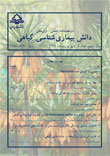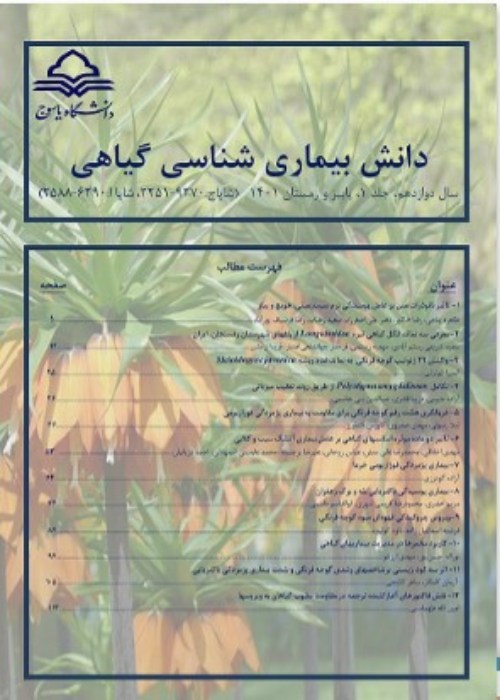فهرست مطالب

نشریه دانش بیماری شناسی گیاهی
سال پنجم شماره 2 (پیاپی 10، بهار و تابستان 1395)
- تاریخ انتشار: 1395/07/06
- تعداد عناوین: 5
-
-
صفحات 1-12قارچ های خوراکی که تحت عنوان دنبلان شناخته می شوند از رده آسکومیست های آپوتس دار می باشند. این قارچ ها اندام بارده خود را در سطح یا زیرزمین تولید می کنند و اکتومیکوریزای اجباری گیاهان هستند. جنس Tuber از راسته Pezizales و رده Pezizomycets است. این جنس دارای گونه های متعددی است که در نقاط مختلف جهان پراکنده می باشند. کشورهای فرانسه، ایتالیا، بریتانیا و نیوزیلند از جمله کشورهایی هستند که در سطح تجارتی نسبت به تولید قارچ های دنبلان اقدام کرده اند. در بین گونه های قارچ های دنبلان خوراکی در دنیا، گونه های دنبلان سفید باارزش Tuber magnatum و دنبلان سیاه باارزش T. melanosporum، از نظر اقتصادی و دارویی ارزش بسیار زیادی دارند. با توجه به ارزش بالای غذایی و دارویی این قارچ ها انجام تحقیقات علمی بیشتر در زمینه شناسایی دقیق آن ها ضرورت دارد.کلیدواژگان: اکتومیکوریز، همزیست، Tuber
-
صفحات 13-22بیماری لکه برگی سرکوسپورایی چغندرقند یکی از مهم ترین بیماری اندام های هوایی این گیاه است. این بیماری در سراسر جهان بیش از یک سوم مناطق کشت چغندرقند را تحت تاثیر قرار داده است. عامل بیماری قارچ Cercospora beticola است. تنوع ریخت شناختی و ژنتیکی زیادی در داخل و بین جمعیت های این گونه گزارش شده است. مدیریت بیماری به روش های زراعی، کاشت ارقام مقاوم و پاشیدن سموم شیمیایی صورت می گیرد. با توجه به خسارت اقتصادی بیماری در ایران، در این مقاله جنبه های مختلف آن شامل معرفی عامل بیماری، زیست شناسی، چرخه بیماری و روش های مدیریتی کارآمد بیماری شرح داده شده است.کلیدواژگان: چغندرقند، مدیریت، Cercospora
-
صفحات 23-31لیموترش یکی از مهم ترین و اقتصادی ترین محصولات باغی در جنوب ایران می باشد. بیماری فیتوپلاسمایی جاروک لیموترش به عنوان یکی از مهم ترین بیماری ها و عوامل تهدیدکننده درختان لیموترش است. عامل بیماری جاروک لیموترش یک فیتوپلاسما با نام پیشنهادی Candidatus phytoplasma aurantifolia می باشد. نشانه های بیماری به صورت ظهور شاخه جارویی در یک قسمت از درخت و سپس گسترش بیماری و افزایش تدریجی تعداد جاروک ها در سایر قسمت ها است. هر جاروک، در واقع از تعداد زیادی شاخه و برگ با فاصله میان گره کوتاه تشکیل شده که رنگ آن ها از سبز کم رنگ تا زرد و اندازه آن ها از کوچک تا بسیار کوچک متغیر است. در شاخه های جارویی خار، گل و میوه تشکیل نمی شود و با افزایش شاخه های جارویی میزان محصول کاهش می یابد. خشک شدن برگ ها در جاروک ها منجر به خشکیدگی شاخه ها یکی پس از دیگری و نهایتا مرگ درختان آلوده طی پنج تا هشت سال می شود. تلفیق روش های مدیریتی شامل از بین بردن درختان آلوده، حذف علف های هرز، قطع جاروک ها و سم پاشی درختان برای مبارزه با حشره ناقل، سبب کاهش سرعت توسعه بیماری می شود. مبارزه شیمیایی و کاهش جمعیت زنجرک ناقل ضمن کاهش انتقال طبیعی بیماری، نقش مهمی در مدیریت بیماری داشته و سیر گسترش بیماری را به تاخیر می اندازد.کلیدواژگان: زنجرک، لیموترش، فیتوپلاسما
-
صفحات 32-41چغندرقند یکی از محصولات اساسی و ماده اولیه صنایع قند و شکر کشور می باشد. نماتد سیستی چغندرقند (Heterodera schachtii) یکی از خسارت زاترین بیمارگرهای چغندرقند به شمار می آید. این نماتد دامنه ی میزبانی وسیعی دارد و 218 گونه از 95 جنس متعلق به 23 خانواده ی گیاهی، از گونه های زراعی، زینتی و علف های هرز را شامل می شود. روش مدیریت این نماتد شامل ممنوعیت کشت در اراضی شدیدا آلوده، کشت زود هنگام (فرار)، تناوب زراعی، استفاده از ارقام مقاوم، استفاده از عوامل دارای توان مهارزیستی بیمارگر، کودهای آلی، کودهای دامی، ضایعات گیاهی، کمپوست، ورمی کمپوست، آفتاب دهی و استفاده از سموم شیمیایی شرح داده شده است.کلیدواژگان: بیماری، چغندرقند، Heterodera
-
صفحات 42-52بیماری پوسیدگی ریزوکتونیایی ریشه با عامل Rhizoctonia solani Kühn از عوامل اصلی ایجاد خسارت در مزرعه لوبیا است. محدود ساختن توسعه گسترده بیماری در مناطق مهم لوبیا کاری کشور نیازمند شناسایی فاکتورهای تاثیرگذار بر وقوع و گسترش این بیماری است. به دلیل نبود ارقام مقاوم به بیماری و عدم کارایی کنترل شیمیایی در خاک، مدیریت زراعی بیماری از اهمیت بسزایی برخوردار است. طبق پژوهش های به عمل آمده برنامه مدیریت تلفیقی بیماری شامل افزایش مواد آلی خاک، تقویت تشکیل گره های ریزوبیومی ریشه، اجتناب از کاشت لوبیا در خاک های شنی، حفظ pH حدود خنثی در خاک زراعی، رعایت فاصله دور آبیاری 9-7 روز در کل فصل زراعی، رعایت تراکم کاشت استاندارد 30 بوته لوبیا در مترمربع، کشت در عمق کمتر از 5 سانتیمتر و شرایط آب و هوایی گرم و خشک، بهره گیری از آبیاری بارانی، کشت لوبیا قرمز در مزارع با سابقه آلودگی، رعایت تناوب زراعی مناسب، مصرف حداکثر 50 کیلوگرم در هکتار اوره، مبارزه با علف های هرز و ضدعفونی بذر با سموم مناسب جذبی پیشنهاد می شود.کلیدواژگان: پوسیدگی ریشه، لوبیا، Rhizoctonia
-
Pages 1-12Edible mushrooms that are known as the truffle are classified in apothecial ascomycetes. They are obligate ectomycorrhiza of plants and produce their fruiting bodies on or below the surface of the soil. The genus Tuber belongs to the order Pezizales, class Pezizomycets, and has numbers of species with universal distribution. So far, France, Italy, United Kingdom and New Zealand have tried for the commercial production of truffle. Among the species of edible truffle of the universe, two valuable species, the white truffle, T. magnatum, and the black truffle, T. melanosporum, are the most valuable species. Because of their economic and medicinal importance, this is necessary to perform scientific research for their accurate identification.Keywords: Ectomycorrhiza, Symbiosis, Tuber
-
Pages 13-22Cercospora leaf spot disease is one of the most important foliar diseases of sugar beet. Over one third of the sugar beet cultivation areas of the world has been affected by this disease. Cercospora beticola is the causal agent of this disease and a high level of interspecific variation of its morphology and genetics has been reported. Disease management is mainly achieved by a combination of cultural practices, cultivation of resistant varieties and application of fungicides. Due to the economic importance of the disease in Iran, some of the different aspects of Cercospora leaf spot disease, including the introduction of disease as well as the biology of the fungus, disease cycle and the efficient measures of disease management, has been reviewed in this paper.Keywords: Cercospora, Sugar beet, Management
-
Pages 23-31Lime is one of the most important economic and horticultural plants in the southern part of Iran. Among the diseases of citrus in south of Iran, Witches Broom Disease of Lime (WBDL) is one of the major citrus diseases. The causal agent of WBDL is a phytoplasma with the proposed name, Candidatus Phytoplasma aurantifolia. The symptoms of disease start with appearance of witches broom at one-side of the infected tree. The disease then spread to whole parts of plant showing leaf proliferation, shortened internodes, small and pale green leaves, no formation of any spine, flower or fruit and finally death of the infected plants. To control the disease, integrated management and cultural practices has shown to be effective methods. Elimination of symptomatic trees as well of the newly emerged infected branches, chemical or mechanical weed control and a periodic spraying by systemic pesticides against the vector insect, or a combination of these methods is highly recommended. Among the control measures, chemical control of the vector has showed is very effective for reducing the disease spread and severity.Keywords: Witches broom, lime, Disease spread, vector, weed control
-
Pages 32-41Sugar beet, is one of the basic source of the raw material for sugar industry in Iran. The beet cyst nematode, Heterodera schachtii Schmidt, 1871, is one of the most damaging pathogens of sugar beet. This nematode has a wide host range, including 218 plant species from 95 genus and 23 families, which include some of the important field crops, ornamental plants and weeds. Nematode management methods include avoiding of cultivation in highly infested soils, disease scape by early cultivation, crop rotation, using resistant varieties, application of bioagents, applying of organic fertilizers, animal manure, plant waste materials, compost, vermicompost and also soil solarization and chemical control are described here.Keywords: Disease, Sugar beet, Heterodera
-
Pages 42-52Rhizoctonia root rot which is caused by Rhizoctonia solani Kühn, seriously reduces the yield of bean. To prevent the widespread distribution of the disease in the main bean growing regions, it requires accurate identification of the effecting factors on disease occurrence and prevalence. Due to the lack of resistant cultivars and ineffectiveness of the chemical measures in the soil, the cultural practices play an important role in disease control. According to the findings, increasing the organic matter, improving the activity of nodule-forming rhizobia on root, avoiding of bean cultivation in sandy soils, maintaining the neutral pH level of soil, irrigation at 7-9 days interval in growing season, planting with a standard density of 30 plants per square meter, seeding at depth of 5 cm in the warm and dry climatic conditions, sprinkler irrigation, kidney beans growing in the infected fields, appropriate rotation program, applying maximum 50 kg urea /ha, weed control, seeder machine adjustment, soil application of fungicides and seed treatment with proper systemic fungicides should be considered in an integrated management program. Proper application of rhizobacteria can effectively reduce the use of chemical fertilizers as a complementary control measure.Keywords: Root rot, Bean, Rhizoctonia


